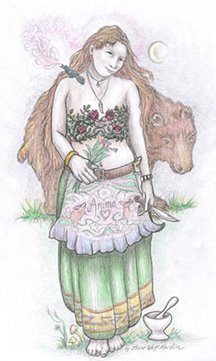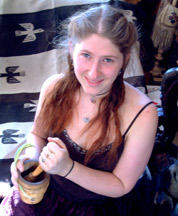
Loba and I woke up early this morning to prepare a picnic lunch to take up the arroyo on a berry picking adventure. We were hoping for ripe Gooseberries and maybe even a Saskatoon (Serviceberry, Shadberry, Juneberry or whatever else you'd like to call it) or two.
In the early morning the air was still chilly and quartz studded boulders that make up the arroyo floor were cool and smooth under our feet as we made our way up from the river into the mountains. Brilliantly colored Butterfly Weed was still blooming profusely every which way we looked, certainly its most prolific year in a long time. I can't wait to harvest a good batch of root this fall! Lavender to fuchsia Monarda blossoms were exploding on both sides of the rocky trail, some of them plants nearly four foot tall. Well, we just couldn't resist and harvested armloads and then bag fulls of richly scented flowering tops. As we walked we noticed we felt euphoric and a bit sleepy from the relaxing effect of the Monarda volatile oils. Also known as Bee Balm, the plants were covered in bees, hummingbird moths and butterflies of all shapes, colors and sizes.
Further up the wash, we discovered that our coveted Gooseberries were not yet ripe, but still swelling into fat green balls of goodness, when completely ripe they turn black purple and tasted like grapefruit mixed with currants and grapes, so yummy! There were a couple dozen black ones hanging from the the prickly bushes and I expect that the rest will be ready in about a week. In the meantime we devoured all the ripe ones in a single burst of bliss, there's really nothing better than ripe wild berries.
Even higher, we stopped for a little lunch of berries, eggs, homemade sauerkraut, rosemary sweet potato salad and Monarda pesto, mmm. And then, we discovered the motherload. Near the top of the arroyo where we once found a sun bleached bear skull and where the Oregon Grape Root and Mountain Valerian grow, we found half a dozen Saskatoon trees weighed down with green fruit, red fruit and nice ripe blue purple fruit. Now, we have plenty of Saskatoon trees here but generally the doves, bears and other critters get to them long before us, so what a treat to stumble upon so many ripe and waiting treats.
Now, if you've never had a Saskatoon, you just need to go out and find yourself one. They look just like high bush blueberries, complete with the bottom crown that blueberries have. They're fat and juicy and taste very very similar to blueberries with an almond crunch at the center, where there's chewy little seeds that are a treat all of their own. They leave this lovely, amaretto aftertaste in your mouth that makes you wander madly through the forest searching desperately for MORE.
We gathered all the ripe ones we could reach which was really only a few cups of berries, but for here, that's a LOT of any kind of berry. There's green ones that should hopefully be ripe just about the same time we come back up for the Gooseberries next week. I also harvested some small branches and bark, as Saskatoon was a common remedy among the Ojibwe and other tribes for pregnant women to prevent miscarriage either as a general pre-natal tonic as well as after a traumatic even or injury. It was also sometimes used to ease childbirth or as a general tonic or tea. Those uses open up a whole realm of possibilities for applications as a woman's reproductive tonic. I'm excited to experiment a bit with this plant and get to know her better. And as with many of the sweet, pleasant tasting types of berries, Saskatoons can be used as an effective and tasty blood tonic for pregnant women or anyone wanting to build blood and increase their intake of whole foods nutrition. And being a less astringent member of the prolific Rose family, they no doubt contain copious amounts of antioxidants and other healthful bits.
Back down the arroyo a bit I found a Wild Cherry tree attempting to take over the pathway so harvested some branches for bark. By the time we reached the spot where the rocks spill out into the river, the sun was high and we were unbelievably hot, so we headed for the beaver pond for a nice swim before returning to the homestead to sort and prepare our bounty. And to find out the prime ways to preserve our luscious Saskatoons!
Oh, and I couldn't help but pull the purple flower petal bits of the Monarda flowers off their bases and pack them into a small jar where I poured raw desert wildflower honey over them, stirring them with a chopstick until the honey was well distributed through the flowers. I'll let these steep for a few months, and save this precious substance for Winter chest colds, sore throats, respiratory difficulties and also for use a powerfully antibacterial and healing wound dressing for burns and infections.
Monday, June 25, 2007
A Walk up the Arroyo: Monarda, Chokecherry, Gooseberries & Saskatoons
Posted by
Oakmoss Changeling
at
7:12 PM
![]()
Labels: Green Tidbits, Tales of the Sweet Medicine
Subscribe to:
Post Comments (Atom)
The Medicine Woman is glad you came...
All writings & posts (c)2007 Kiva Rose
All artwork & photographs (c) 2007 Jesse Wolf Hardin












6 comments:
Ohhh, I'm so jealous. We saw fields of flowering monarda yesterday, all on hyper protected open space park land, with rangers roaming a plenty. Not a good place to collect from. Boulder is annoying place to try to be a wildcrafter. EVERYTHING is protected land, with large fines if you pick the flowers.
I long for wilderness.
I tried planting her, and she never came up in the garden.
Sigh.
Last time I ate service berries they didn't taste that good!! The canyon is such a special place for growing things!
We're your cherries already putting on fruit? I've learned not to collect until the plant set fruit, because the amount of some of the possibly toxic cyanide compounds changes(decreases) after setting fruit. I always collected in late summer. I can't wait for the choke cherries to be ripe here. Chokecherry fruit and bark syrup for coughs! You bet!!
When you come visit in Sept. you can dig some to take back with you if you like, we have lots and lots.
Yep, the Cherries have big green fruits on them but something is eating most of them. I learned to harvest anytime after the fruit started growing, usually from July 1st til late Summer, and since this particular tree needed a trim anyway I took a few branches. I'll do most of my harvesting later on this Summer though and compare it to this batch. I want to use Chokecherry especially for heart problems associated with excess heat and as a nervine this year, since I've already worked with the cough and fever aspects. Oh, I love the Rose family plants!!
What a beautiful sounding day and accompanied by such a beautiful picture! I love reading your blog Kiva, thank you for all your posts. I'll be thinking of you all this week and wishing I was there for the gathering. My love.
Yummy!! I got curious about the Blueberries ....turns out they are not in the Rosacea family but rather the Ericacea or Honeysuckle family ... so interesting!
What a glorious walk, Kiva, so bountiful and blissful. You lucky womon! Thank you for writing!
Love
a
Blueberry is very closely related to Cranberry which is why they can be used interchangeably in a lot of ways. The Heath family, Ericacea, also inlcudes Manzanita, Heather, Azalea and Pyrola.
The Honeysuckle family is Caprifoliaceae though, which USED to include Elderberry but it has now been moved over the Adoxaceae family with the Viburnums.
It's interesting that the Saskatoon (Amelanchier) berries so closely resemble Blueberries, but they are definitely Rose family members, you can totally tell by their flower and leaves.
The Monarda flower honey sounds amazing. I'll have to do that this year.
Post a Comment